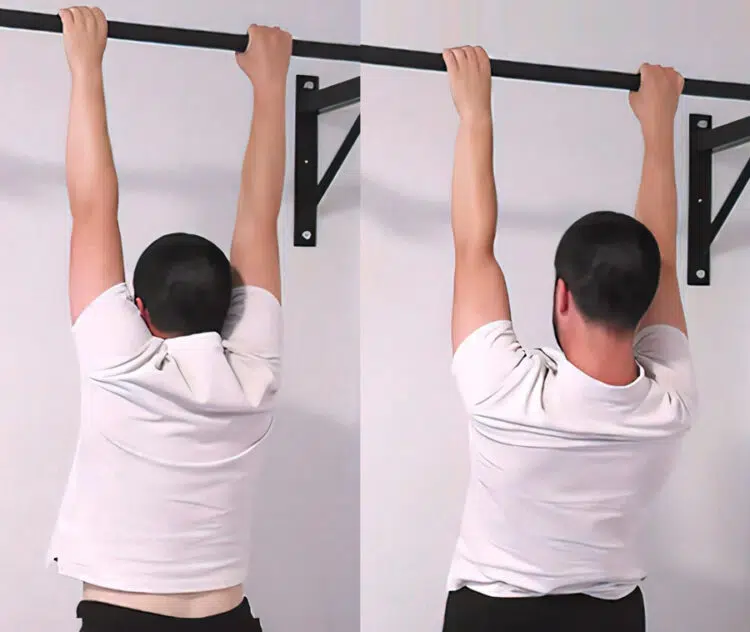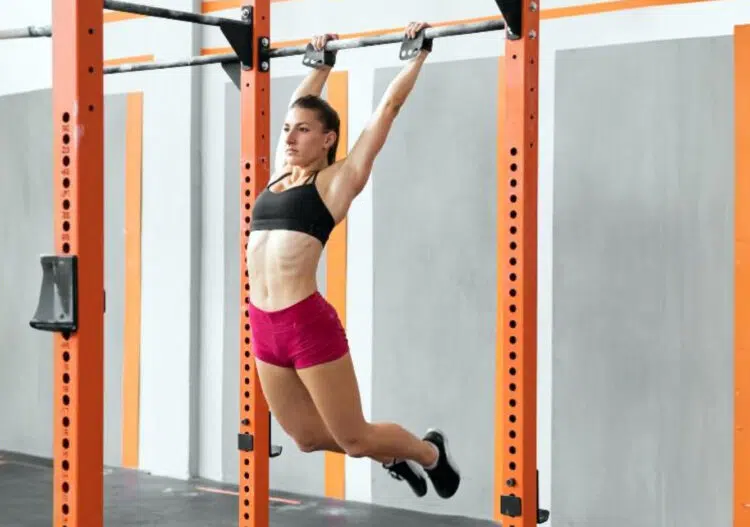‘Dead hangs’ might sound a bit intense, but it’s not what you are probably imagining. This exercise involves hanging onto a pull-up bar, which primarily targets the forearms, lats, traps, shoulders, and core. As a veteran personal trainer, I program this into most of my clients’ routines and have seen incredible success with it.
Dead hangs are an incredibly effective exercise for improving grip strength, decompressing the spine, increasing shoulder mobility and stability, and correcting posture. Plus, this incredibly versatile isometric exercise is suitable for exercisers of all experience levels.
Although this exercise might look remarkably easy, it involves many nuances. Neglecting these details can cause serious injuries. In this article, I take you over five mistakes that most people make while performing dead hangs that compromise safety and effectiveness, the issues they can cause, and how to correct them.
Mistake 1: Improper Grip

The grip is one of the most critical aspects of a dead hang. Grabbing the bar incorrectly can strain your upper body joints and increase the risk of injury. Also, you cannot overload this exercise until you’ve mastered the proper gripping technique.
An overhand, shoulder-width grip is the most common gripping technique for this exercise. However, it can vary depending on your structure. For instance, people with broader shoulders might find a wider grip more suitable.
Experiment with different hand placements around the shoulder width apart to determine what works best for you. Going too wide or narrow can cause wrist strain and shoulder impingement.
Level Up Your Fitness: Join our 💪 strong community in Fitness Volt Newsletter. Get daily inspiration, expert-backed workouts, nutrition tips, the latest in strength sports, and the support you need to reach your goals. Subscribe for free!
Remember, your dead hang performance is as strong as your grip strength. I recommend that my clients add forearm exercises like reverse wrist curls and farmer’s walk to improve their lower arm strength. Also, using a fat grip attachment can help maximize forearm stimulation and muscle and strength gains. (1)
Mistake 2: Shrugging Shoulders
Shrugging the shoulders during dead hangs is a common trait amongst beginners as they try to remove the tension from their forearms and transfer it to their shoulders and upper back.
However, relaxed, fully extended shoulders are vital for maximizing lat stimulation during dead hangs. Raising your shoulders toward your ears might give your forearms temporary relief but can cause neck strain and upper back pain as it causes thoracic spine overextension.
People with limited shoulder and overhead mobility might find it more challenging to fully extend their arms during dead hangs. Folks with this issue should spend 10 to 15 minutes daily doing dynamic and static stretches to improve their range of motion (ROM).
Here is a list of 10 exercises that should be a part of your arsenal:
- Arm circles
- Shoulder rolls
- Cross-body arm stretch
- Pendulum swings
- Wall slides
- Scapular push-ups
- Chest opener
- Overhead tricep stretch
- Child’s pose
- Thread the needle
Do a few of these exercises for five minutes to warm up for the dead hangs. Five minutes of static stretches after the dead hang session can help flush metabolites and promote recovery.
Mistake 3: Swinging or Kicking Legs
Many exercisers end up swinging like Tarzan during this exercise. This issue is even more common in people who jump and grab the pull-up bar. A dead hang should involve absolutely zero motion.
Swinging or kicking during the dead hangs can lead to a loss of control and increase the risk of falls, increasing injury risk.
You must consciously brace your core muscles (obliques, abs, diaphragm, pelvic floor muscles, lats, erector spinae, and glutes) throughout the exercise to limit movement. I recommend taking long, deep breaths and focusing on contracting the glutes, abs, and lats to ensure stability.
If you find yourself swinging, end the set, reset your form, and try again. It is always better to cut an exercise short and reset your technique than to perform it with an incorrect form, as it shoots up the risk of injury.
Keep your legs straight, squeeze the bar harder, and breathe deeply for a more controlled, static hang. Also, beginners must start small (10-15 second hangs) and progressively increase the time. Aiming for a longer time from the beginning usually causes discomfort, leading to excessive swinging and instability.
Mistake 4: Bending the Elbows
This is another classic dead hang mistake. Most people bend their elbows as they begin to fatigue. They assume this will transfer some of the tension from the forearms to the biceps. However, flexing the elbows is the most counterproductive thing you can do when your grip starts giving out.
First, the biceps are not a target muscle during dead hangs. Besides the biceps, elbow flexion engages the rear and anterior deltoids and takes tension off the lats. Finally, holding this awkward position for too long can cause elbow and shoulder joint strain. You might also experience bicep tendon and ligament strain, which are more prone to injury and can take a long time to heal.
It is always better to end the set when your grip starts to fail and begin after an appropriate amount of rest. Folks training for strength or muscle gains can rest between one to three minutes between sets to allow the forearms enough time to recover. (2)
End your set if you feel a sudden, sharp elbow or bicep tendon pain during the exercise. Consult your healthcare provider if the pain doesn’t subside within a couple of days.
Remember, your entire body weight is on your wrist, elbow, and shoulder joints during this exercise. You must learn to listen to your body and pay close attention to any red flags. Consistently pushing your body too hard can hamper your performance, increase injury risk, and cause chronic fatigue, mood swings, and irritability.
Mistake 5: Progressing Too Quickly
Level Up Your Fitness: Join our 💪 strong community in Fitness Volt Newsletter. Get daily inspiration, expert-backed workouts, nutrition tips, the latest in strength sports, and the support you need to reach your goals. Subscribe for free!
Using added resistance too soon is one of the most common mistakes I see people make with dead hangs. Although intermediate and advanced lifters might find bodyweight dead hangs easy, sticking to a gradual progression plan will ensure consistent gains and limit the risk of injury.
Here are a few sample dead hang progression plans for people of different experience levels:
Beginners:
Novices should start with three sets of 10-second dead hang holds. Since these are shorter hold times, limit the rest time between sets to 30 seconds. Focus on maintaining a proper form throughout the exercise. I encourage you to film yourself to find any pitfalls in your form.
Gradually increase the hold duration by five seconds each week until you can do an unbroken 30-second dead hang. Since this is a low-impact exercise, you can do it every day.
Intermediate:
At this level, you must increase the number of sets to four. However, you will still stick to a 30-second rest time between sets. Although you will begin with 30-second holds, aim to work up to 45-second holds by the end of the four weeks.
You can also add more challenging dead hang variations to your routine for greater target muscle stimulus. Here are the ones you should consider:
- Active hang
- Single-arm dead hang
Advanced:
This is where you put things into top gear. You must aim for 45-60 seconds or longer during this phase. Plus, you must experiment with more challenging variations, such as weighted hangs or towel hangs, to ensure consistent progress.
Feel free to lower your training frequency to allow your body enough time to recover between the workouts.
How To Perform Dead Hangs
This is how to do this exercise to get the best bang for your buck while minimizing the potential for injury:
Step One — Stand on an Elevated Platform
I advise against jumping and grabbing the pull-up bar, as it can strain the wrist, elbow, and shoulder joints. Plus, it is highly unlikely that you can establish a secure grip on the bar using this technique.
Instead, stand on an elevated platform like a flat bench set perpendicular to the pull-up bar or a dumbbell.
Coach Tip: Avoid using an aerobic stepper as they are usually not high enough to allow you to grip the bar comfortably and can obstruct a free hang.
Step Two — Grab the Pull-Up Bars
Your grip will dictate the exercise’s effectiveness, but many still treat it as an afterthought. Grab the bar with a shoulder-wide overhand grip. More experienced trainers can opt for a hook grip to aim for a longer hold time.
Conversely, beginners can use lifting straps to eliminate grip strength and bias the lats. However, the use of grip aids should only be limited. Implement grip strength exercises into your regime to iron out these weaknesses.
Coach Tip: Your ideal grip width can vary depending on your biomechanics. Experiment with different grips until you find what works best for you.
Step Three — Hang onto the Bar
Once you’ve established a secure grip on the bar, lift one foot off the elevated surface, followed by the other. Fully extend your elbows and shoulders and look straight ahead. Keep your core braced to ensure stability.
Point your toes to achieve a deeper lat fiber stretch. However, taller individuals might have to curl their toes to avoid touching the floor. Hold for as long as possible. Start with a 10 to 30-second hold, whereas experienced folks can target two minutes.
Coach Tip: Avoid looking toward the ceiling, as it can strain the neck.
Step Four — Dismount
Your dismounting technique will vary depending on your height and setup. If your feet are a few inches off the floor, you can simply let go of the bar. However, if you are hanging onto a higher bar or using lifting straps, step back onto the elevated surface instead of crashing onto the floor.
Coach Tip: A hard landing can cause lower body joint sprain, especially the ankles, which are susceptible to injury.
Next Read: How a 2-Minute Hanging Habit Transforms Your Body (Science Explained)
Conclusion
Dead hangs are an incredibly effective exercise for boosting grip strength, shoulder mobility, and stability, decompressing the spine, and correcting posture. However, this unassuming exercise can result in a host of painful and potentially debilitating injuries if done recklessly.
Avoid shrugging the shoulders, swinging or kicking during the exercise, and flexing the elbows to maximize gains while limiting injury risk. Employing a balanced progression plan while sticking to a picture-perfect form is key to ensuring consistent progress with dead hangs.
If you have any questions about the dead hangs or need help implementing them into your routine, post them in the comments section below, and I’ll be happy to help!
References:
- Krings, B. M., Shepherd, B. D., Swain, J. C., Turner, A. J., Chander, H., Waldman, H. S., McAllister, M. J., Knight, A. C., & Smith, J. W. (2021). Impact of Fat Grip Attachments on Muscular Strength and Neuromuscular Activation During Resistance Exercise. Journal of strength and conditioning research, 35(Suppl 1), S152–S157.
- Schoenfeld BJ, Grgic J, Van Every DW, Plotkin DL. Loading Recommendations for Muscle Strength, Hypertrophy, and Local Endurance: A Re-Examination of the Repetition Continuum. Sports (Basel). 2021;9(2):32. Published 2021 Feb 22. doi:10.3390/sports9020032











I know a person who is having extreme problems with her frame (painful neck and back joint/vertebral subluxations) and must stand most of the day and must lay a certain way when sleeping to prevent the joints from dislocating and causing terrible pain. It’s as though her joints, tendons, ligaments are too weak. Could the careful use of dead hangs or similar exercises perhaps be helpful for her?
Hello. It’s excellent. Only I would like to watch some excercises. Thanks.